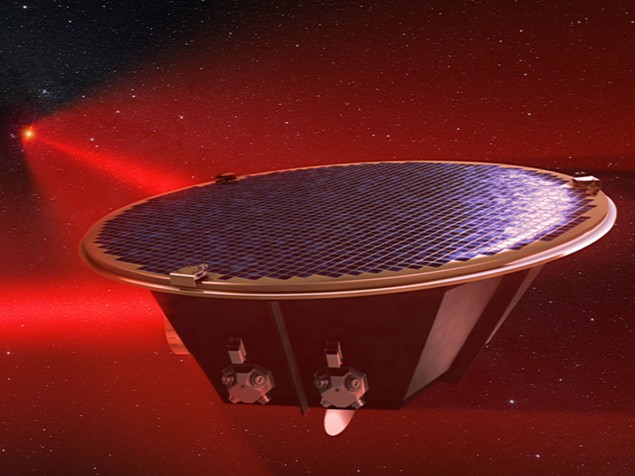Ian Randall reviews At the Edge of Time: Exploring the Mysteries of Our Universe’s First Seconds by Dan Hooper

A new era in astronomy began on 14 September 2015 when the Laser Interferometer Gravitational-wave Observatory (LIGO) in the US states of Louisiana and Washington made the first direct detection of gravitational waves. These were generated some 1.3 billion years ago, when two colossal black holes collided. In the upcoming two decades or so, the European Space Agency’s Laser Interferometer Space Antenna (LISA) should be in orbit around the Sun, with three spacecraft working in perfect unison, each at a distance of 2.5 million kilometres from the other. The experiment aims to measure the background of lower-frequency primordial gravitational waves left rippling across the universe by the Big Bang. In this way, LISA is expected to open an unprecedented window for physicists to learn how our universe, as we know it, came to be.
For a book, to quote from its subtitle, “exploring the mysteries of our universe’s first seconds”, US cosmologist and particle physicist Dan Hooper’s At the Edge of Time has as much of an eye on the future of cosmology (and the potential of upcoming projects such as LISA) as it does on the most distant of pasts. As part of Princeton University Press’s “Science Essentials” series, Hooper has undertaken the daunting feat of taking what are arguably some of the most confounding topics in modern science and presenting them in a readily digestible and coherent form.
The open-ended nature of the questions raised by topics such as dark matter do not lend themselves well to the traditional narrative format
The very open-ended nature of the questions raised by topics such as dark matter, cosmic inflation and the multiverse do not lend themselves well to the traditional narrative format, as Hooper notes at the end of the first chapter, writing “If you are looking for a story with an ending that wraps up nicely, you may have chosen the wrong book.” Nevertheless, the book guides the reader through the history and many enigmas of the universe in the aftermath of the Big Bang.
Starting with the implications of Albert Einstein’s theory of relativity, Hooper touches on a multitude of cosmological concepts – including the 17 fundamental forms of energy and matter that make up the Standard Model of particle physics, and the matter–antimatter asymmetry problem – before delving into more speculative areas. These include the nature of dark matter, needed to account for the behaviour of galaxies; the possibility of multiple universes; and the existence of extra dimensions.
Hooper is a charming guide to the world of modern cosmology – one who pleasingly blasts through the tired and unhelpful stereotype of the perfectly objective scientist to paint a more relatable and human profile. “To those of us hunting dark matter, pulsars are often the bane of our efforts,” he writes, continuing with the quip that “despite all the reasons to be fascinated by these objects, there are few things in our universe that I hate more than pulsars.”
This quote crops up in what is perhaps the work’s most intriguing chapter, roughly in the middle of the book, in which Hooper discusses some of his own research, as he describes a putative signal of dark matter being annihilated, as detected in the heart of our Milky Way galaxy. Or perhaps the signal might instead be the product of unseen thousands of the aforementioned and despised pulsars. Hooper’s style here is distinct, and the chapter opening suggests it might offer a day in the life of a physicist – or, as a friend of Hooper’s is said to have put it, “So you walk into your office. You take off your coat. You get yourself a cup of coffee. How do you know what to do next?”
From a public engagement standpoint, there is merit in demystifying the daily activities of researchers for a general readership, so it feels like a missed opportunity that Hooper instead moves quickly into broader considerations, albeit in a way that still shines a light on the process of consensus-making in the production of scientific knowledge. For the cynical, however, wry amusement might be found in this chapter’s epigraph – poet James Whitcomb Riley’s aphorism about things that quack like ducks being ducks – which appears to subvert Hooper’s later caution that this is not always so when considering one’s pet interpretations.
Given the high standards of the work overall, it is a shame that At the Edge of Time’s few real flaws stem from the same elementary mistakes that so often beset popular-science texts. In parts, the book contains a lot of repetition, to the extent that I couldn’t help wondering if the material was compiled from a series of educational lectures. This issue peaks in recap summary transitions between chapters, which detract from the book’s momentum more than they add value to the material covered. Names of researchers who the average reader may not be familiar with – such as Ben Lee, Dave Schramm and Floyd Stecker – appear with such little context, their identities might as well have been forgone in favour of a crisper focus on their work. I fear I may also go to my grave deprived of an explanation of exactly what non-Gaussianities in the cosmic microwave background are – and why exactly I should care about them – after they received a largely unelaborated name-drop in one of the latter chapters.
No review of At the Edge of Time would be complete, however, without a nod to what, I confess, superficially attracted me to the book in the first instance – the psychedelic cover, illustrated by the Bali-based design duo who go by the name Sukutangan. All in all, At the Edge of Time is a delightful and compelling book – one that is ideal to introduce the general reader to modern cosmology without ducking from the field’s many unresolved facets.
- 2019 Princeton University Press 248pp £22hb



